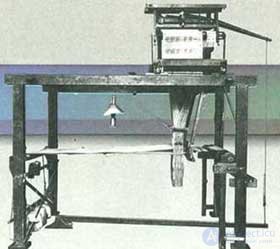The next step in the development of computing devices seemed to have nothing to do with numbers, at least at the beginning. Throughout the XVIII century. French factories for the production of silk fabrics experimented with various mechanisms that controlled the machine with punch ribbons, punch cards or wooden drums. In all three systems, the thread rose and fell in accordance with the presence or absence of holes - this was how the desired fabric pattern was created. In 1804, engineer Joseph Marie Jacquard built a fully automated machine capable of reproducing complex patterns. The work of the machine was programmed with the help of a whole deck of punched cards, each of which controlled one shuttle stroke. Moving on to a new pattern, the operator simply replaced one deck of punch cards with another. Jacquard's machine tool caused a real revolution in weaving as well. the principles underlying it are used to this day. However, the most important role of punch cards was destined to play in computer programming.
 | 1804 In the Jacquard machine for the management of production operations were first used punch cards. |
Of all the inventors of the past centuries, who made one or another contribution to the development of computer technology, the Englishman Charles Babbage came closest to creating a computer in its modern sense. Born in 1791 in Devonshire in a rich family, Babbage became famous for his wit and his eccentricities. For 13 years, this eccentric genius was in charge of the mathematics department at the University of Cambridge (Newton once held this post), but he did not live a single day at the university and did not read a single lecture there. Babbage was one of the founders of the Royal Astronomical Society, the author of all sorts of essays on a variety of topics - from politics to production technology. He took part in the creation of various devices, in particular, a tachometer, and devices, for example, a safety grid for a railway locomotive, which made it possible to throw objects from an accidental path. Babbage dealt with such serious problems as calculating the mortality of the population and the reform of the postal service, without disdaining even more trivial matters. For many years, he unsuccessfully fought with street organ-grinders, whose play put him out of himself. When Babbage died, the Times of London wrote about him as a man who lived to almost 80 years, "despite the persecution by the organ-grinders."
However, the main passion of Babbage was the struggle for impeccable mathematical accuracy. He literally declared a “crusade” against errors in the tables of logarithms, which were widely used by astronomers, mathematicians and long-distance navigators in the calculations. Nothing escaped his attentive gaze. Once he sent a letter to poet A. Tennyson, in which he sharply criticized his lines “Every moment a person dies, every moment another is born.” Since the population of the Earth does not remain constant, Babbage noted, these lines should be brought into conformity with the truth as follows: "Every moment one person dies, every moment one and one sixteenth of the other is born."
The highest achievement of Charles Babbage and at the same time his greatest pain was the development of the principles underlying the modern computer, a whole century before the technical possibility of their realization appeared. He spent several decades, large government subsidies and a significant portion of his own funds in unsuccessful attempts to create a computer running on these principles.

Comments
To leave a comment
History of computer technology and IT technology
Terms: History of computer technology and IT technology